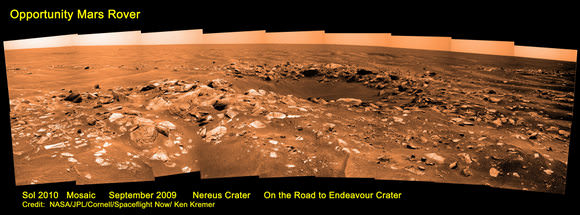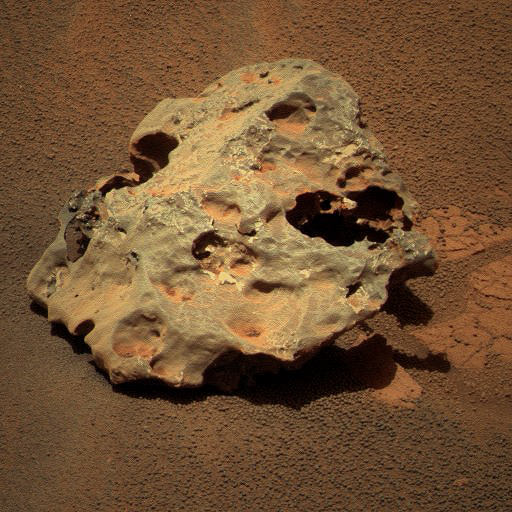[/caption]
Mackinac on Mars. Credit: NASA/JPL/ colorization by Stuart Atkinson
Opportunity must be driving down Meteorite Alley on Mars. The rover has come across still another meteorite, the third space rock it has found the past few months, and fourth overall since 2005. This one is called Mackinac, which continues the “island” theme by which the science team has dubbed the meteorites. Block Island was found in July 2009, and Opportunity came upon Shelter Island the end of September (around sol 2020 for the rover). Mackinac was found on sol 2034 (Oct 13), and it looks very similar in composition to the two earlier meteorites. Opportunity analyzed the Block Island and found it was made of iron and nickel.
The image above was color calibrated by Stu Atkinson, who hangs out at UnmannedSpaceflight.com. You can find all the raw images Opportunity has sent back to Earth here, and raw images from Spirit here. But you can also follow Opportunity in other ways….
You can keep track of Opportunity’s travels through Meridiani Planum on its way to Endeavour Crater at one of Stu’s blogs, Road to Endeavour. But — and this is very fun — you can also follow Oppy on Google Mars, and see where it has found the meteorites. Tesheiner on UMSF regularly updates a route map, pinpointing the spots where the rover stops. Just go to Google Mars (download Google Earth and Mars here if you don’t have it yet), open up Google Mars, then click on this link, download and open, and you’ll be transported to Opportunity’s location on Mars. Extreme, extreme cool.
Now, you’ll notice that region of Google Mars doesn’t have high-resolution imagery yet. They’re working on it. In the meantime, though, if you want to see a great mosaic of the terrain that Opportunity is traveling through, check out this image below created by Ken Kremer, also of UMSF. This is from Sol 2010 showing Nereus Crater and dunes on the Road to Endeavour, where Oppy was just prior to discovering Shelter Island. The crater is about 10 meters across. Ken created this mosaic from raw images from the Cornell Pancam raw images, stitching multiple images together and calibrating the color. Beautiful! Click the image for a larger version over at Spaceflightnow.com. This image is also the Oct. 19 Astronomy Picture of the Day.
Thanks to Stu, Tesheiner and Ken for sharing their incredible Martian handiwork!

Opportunity mosaic from Sol 2010 showing Nereus Crater and dunes on the Road to Endeavour Crater. Credit: NASA/JPL/Cornell/Spaceflight Now/Ken Kremer. Used by permission. Click image for larger version


Keep on trucking little Opportunity!
Well, if Meridiani has weathered down as much as they think, it _is_ a meteorite conveyor belt of sorts IMHO.
Speaking of weathering, that was one husk of a meteorite! Thanks as always for the eye-catching imagery.
I just love this…a spacecraft from Earth, on Mars taking a picture of a rock from space…
kcuhC
All of these meteorites are likely from the same meteoroid that broke up the the atmophere and fell in the same region.
LC
Does anyone know what colorization Stu Atkinson did for the top picture of the meteor on Mars? The images I make (combining filters L4, L5, and L6) usually make the “blueberries” much darker, with a bluish tint.
This one DEFINATELY looks like a dragon’s skull.. same material anyway…
All kidding aside… WOW! The little rover’s that kept on giving and giving and yas! giving! I like and can’t wait to see the data! HO!
Let’s talk about robotics to utilize this resource… WOW! In situ high density Ni-Iron on Mars! Now WHAT would I want to do with THAT? (Grins sheepishly ear to ear)
Lets talk structural.. lets talk antenna array…
Lets talk…. how ‘yummy’ can you get? YAS!
Samari sword… hei!
…To slay dragon…
It looks more like a dog’s head to me….
Wonderful images! As Aqua says, this little rover just continues to do great science. I would certainly say NASA has gotten its money’s worth.